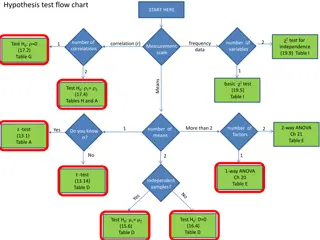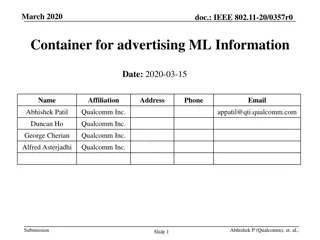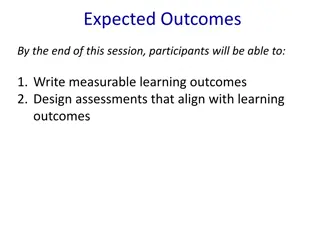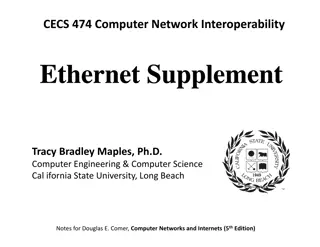
Dealing with Challenges in Cochrane Skin Reviews: Tips from Dr. Emma Mead
"Learn how to handle large reviews with multiple comparisons and outcomes, choose main comparisons and outcomes, prioritize in summary sections, and create effective Abstracts and Plain Language Summaries with insights from Dr. Emma Mead's Cochrane Skin review methods."
Download Presentation

Please find below an Image/Link to download the presentation.
The content on the website is provided AS IS for your information and personal use only. It may not be sold, licensed, or shared on other websites without obtaining consent from the author. If you encounter any issues during the download, it is possible that the publisher has removed the file from their server.
You are allowed to download the files provided on this website for personal or commercial use, subject to the condition that they are used lawfully. All files are the property of their respective owners.
The content on the website is provided AS IS for your information and personal use only. It may not be sold, licensed, or shared on other websites without obtaining consent from the author.
E N D
Presentation Transcript
Common problems with Cochrane skin reviews Dr Emma Mead Cochrane Skin systematic review methodologist 16thJanuary 2018, CSG-COUSIN meeting Trusted evidence. Informed decisions. Better health.
Interventions for reviews Scope is wide will likely include a large number of interventions Multiple outcome measures, multiple timepoints Pooling may be challenging Summary sections (e.g. abstract) difficult to write Important at protocol stage to choose the main comparisons, and to think carefully about your outcomes Takes a lot of time and resource likely needs an update search!
How to deal with: 1) Large reviews with multiple comparisons and outcomes 2) Outcomes measured using different instruments/scales
Large reviews with multiple comparisons and outcomes
Summary sections of the review Summary of findings (SOF) tables Abstract Plain language summary (PLS) Discussion>summary of main results In large reviews with multiple comparisons and outcomes, need to prioritise Word limit on abstract and PLS
Summary of findings (SOF) tables Protocol stage, decide on main comparisons you will create SOF tables for Choose up to 7 outcomes (all primary and key secondary) Include measure of safety Other considerations include timepoints and instruments/scales If these change during the review stage, justify in Differences between protocol and review section
Abstract Word limit so need to prioritise what is reported Results in your SOF tables May need to prioritise comparisons further if large number of SOF tables Don t have to report all outcomes in the SOF tables but should report primary outcomes (plus a measure of safety) Each comparison included in this section needs to report the same outcomes
Plain Language Summary (PLS) and Discussion>Summary of main results Should reflect what is reported in your abstract PLS results reported in plain language Discussion>summary of main results narrative description of the results
Outcomes measured using different instruments/scales
Protocol stage Really important to carefully think about the outcomes you select For each outcome, consider how you will handle multiple timepoints, and outcome measures Will you restrict to certain timepoints? Will you only consider certain measures of an outcome? Will there be a hierarchy?
How to handle multiple measures of the same outcome? E.g. quality of life measured using different scales Option 1: include all scales (or a large number) and present the results for each scale separately and not pool Difficult to summarise Option 2: restrict to only one or two scales May lose a lot of data Option 3: for continuous data, use the standardised mean difference (SMD) Can be quite difficult to interpret
Standardised mean difference (SMD) For continuous data: The standardized mean difference is used as a summary statistic in meta-analysis when the studies all assess the same outcome but measure it in a variety of ways (for example, all studies measure depression but they use different psychometric scales). In this circumstance it is necessary to standardize the results of the studies to a uniform scale before they can be combined. The standardized mean difference expresses the size of the intervention effect in each study relative to the variability observed in that study (Cochrane handbook, version 5.1, Chapter 9.2.3.2)
SMD Pain scores Remember, if the direction of scales is different you need to multiply the mean values from one set of studies by -1 to ensure the scales all point in the same direction. Sedgwick, P. and Marston, L., 2013. Meta-analyses: standardised mean differences. BMJ: British Medical Journal (Online), 347
How to interpret SMDs (1) E.g. SMD -1.28 (95% CI -2.22 to -0.35) Report as SD units Mean score in the intervention group is 1.28 standard deviations lower (2.22 to 0.35 lower) than in the control group Cohen s interpretation of SMD effect sizes: 0.2 = small effect 0.5 = moderate effect 0.8 = large effect But these interpretations are limited as do not account for the context of the findings
How to interpret SMDs (2) The SMD can be converted to show the difference on a familiar scale Select one study from your SMD meta-analysis using your preferred scale (should be low risk of bias and representative of population and intervention) Multiply SMD (and 95% CI limits) by SD from the control group This will give the mean difference (95% CI) for the chosen scale This method can be challenging as it may be difficult to decide which study to use Could use a SD from an observational study Could use a range of SDs as a sensitivity analysis if concerned about the chosen SD
To summarise For very broad reviews, important to prioritise the main comparisons and outcomes of interest (at protocol stage) Also prioritise timepoints and instruments/scales For continuous outcome measures expressed using different instruments/scales, consider using SMD Writing the abstract/PLS should be much easier Other options include doing a network meta-analysis, or do a more targeted review






















